Silvio Mandelli
Angular Estimation Comparison with ISAC PoC
Oct 25, 2025Abstract:The introduction of Integrated Sensing and Communications (ISAC) in cellular systems is not expected to result in a shift away from the popular choice of cost- and energy-efficient analog or hybrid beamforming structures. However, this comes at the cost of limiting the angular capabilities to a confined space per acquisitions. Thus, as a prerequisite for the successful implementation of numerous ISAC use cases, the need for an optimal angular estimation of targets and their separation based on the minimal number of angular samples arises. In this work, different approaches for angular estimation based on a minimal, DFT-based set of angular samples are evaluated. The samples are acquired through sweeping multiple beams of an ISAC proof of concept (PoC) in the industrial scenario of the ARENA2036. The study's findings indicate that interpolation approaches are more effective for generalizing across different types of angular scenarios. While the orthogonal matching pursuit (OMP) approach exhibits the most accurate estimation for a single, strong and clearly discriminable target, the DFT-based interpolation approach demonstrates the best overall estimation performance.
Benchmarking CFAR and CNN-based Peak Detection Algorithms in ISAC under Hardware Impairments
May 16, 2025



Abstract:Peak detection is a fundamental task in radar and has therefore been studied extensively in radar literature. However, Integrated Sensing and Communication (ISAC) systems for sixth generation (6G) cellular networks need to perform peak detection under hardware impairments and constraints imposed by the underlying system designed for communications. This paper presents a comparative study of classical Constant False Alarm Rate (CFAR)-based algorithms and a recently proposed Convolutional Neural Network (CNN)-based method for peak detection in ISAC radar images. To impose practical constraints of ISAC systems, we model the impact of hardware impairments, such as power amplifier nonlinearities and quantization noise. We perform extensive simulation campaigns focusing on multi-target detection under varying noise as well as on target separation in resolution-limited scenarios. The results show that CFAR detectors require approximate knowledge of the operating scenario and the use of window functions for reliable performance. The CNN, on the other hand, achieves high performance in all scenarios, but requires a preprocessing step for the input data.
Optimal Azimuth Sampling and Interpolation for Bistatic ISAC Setups
Apr 27, 2025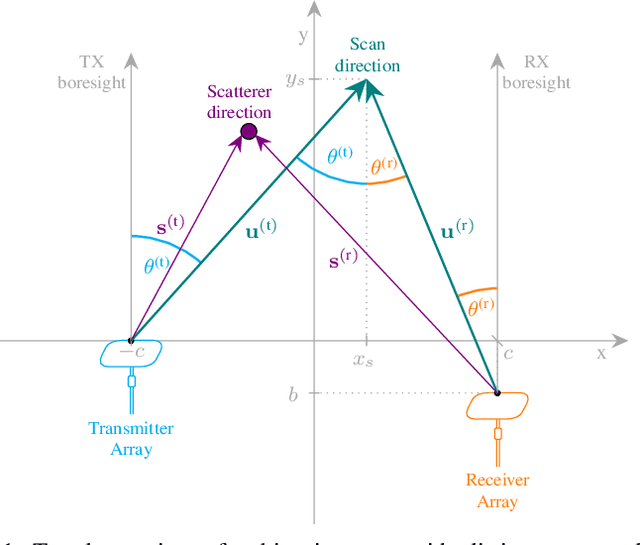
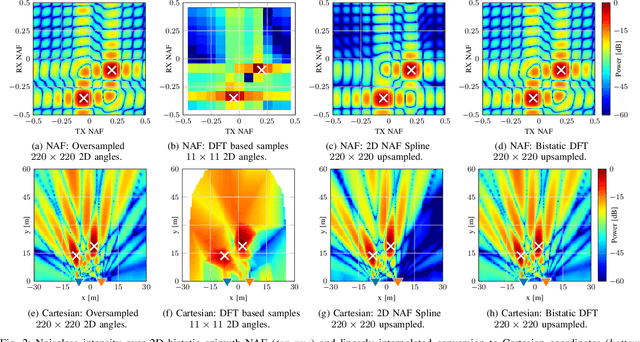


Abstract:A key challenge in future 6G Integrated Sensing and Communications (ISAC) networks is to define the angular operations of transmitter and receiver, i.e., the sampling task of the angular domains, to acquire information about the environment. In this work we extend previous analysis for optimal angular sampling of monostatic setups to two-dimensional bistatic deployments, that are as important as the former in future ISAC cellular scenarios. Our approach overcomes the limitations of suboptimal prior art sampling and interpolation techniques, such as spline interpolation. We demonstrate that separating azimuth operations of the two transmit and receive arrays is optimal to sample the angular domain in an array-specific normalized angular frequency (NAF). This allows us to derive a loss-less reconstruction of the angular domain, enabling a more efficient and accurate sampling strategy for bistatic sensing applications compared to legacy approaches. As demonstrated by different Monte Carlo experiments, our approach enables future bistatic ISAC deployments with better performance compared to the other suboptimal solutions.
Target Detection for ISAC with TDD Transmission
Apr 27, 2025Abstract:Integrated sensing and communication (ISAC) poses various challenges that arise from the communication-centric design of cellular networks. One of them is target detection with time division duplex (TDD) transmission used in current 5G and future 6G deployments, where the periodic on-off behavior of the transmitter creates impulsive sidelobes in the radar point spread function (PSF). These can be mistaken for actual targets by conventional peak detection techniques, leading to false alarms. In this work, we first analytically describe the range-Doppler PSF due to TDD windowing. We then propose a computationally efficient method that leverages the PSF to distinguish impulsive sidelobes from valid target peaks. Simulation results and outdoor drone measurements with an ISAC proof of concept demonstrate the capability of our algorithm, showing that it can achieve reliable target detection while limiting false alarms.
Integrated Long-range Sensing and Communications in Multi Target Scenarios using CP-OFDM
Jan 20, 2025Abstract:6G communication systems promise to deliver sensing capabilities by utilizing the orthogonal frequency division multiplexing (OFDM) communication signal for sensing. However, the cyclic prefix inherent in OFDM systems limits the sensing range, necessitating compensation techniques to detect small, distant targets like drones. In this paper, we show that state-of-the-art coherent compensation methods fail in scenarios involving multiple targets, resulting in an increased noise floor in the radar image. Our contributions include a novel multi target coherent compensation algorithm and a generalized signal-to-interference-and-noise ratio for multiple targets to evaluate the performance. Our algorithm achieves the same detection performance at long distances requiring only 3.6% of the radio resources compared to classical OFDM radar processing. This enables resource efficient sensing at long distances in multi target scenarios with legacy communications-only networks.
Bistatic Information Fusion for Positioning and Tracking in Integrated Sensing and Communication
Oct 15, 2024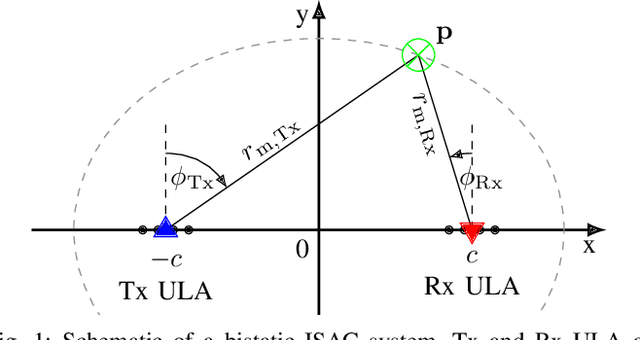
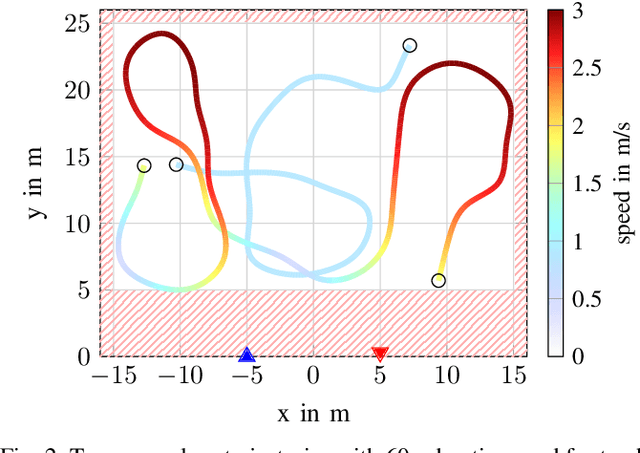
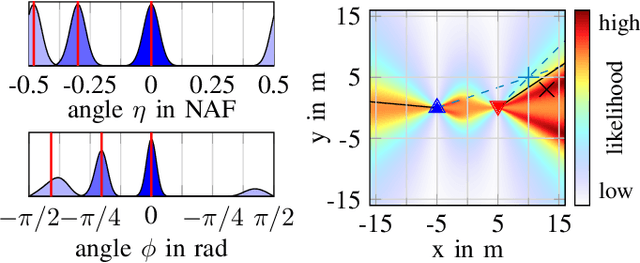
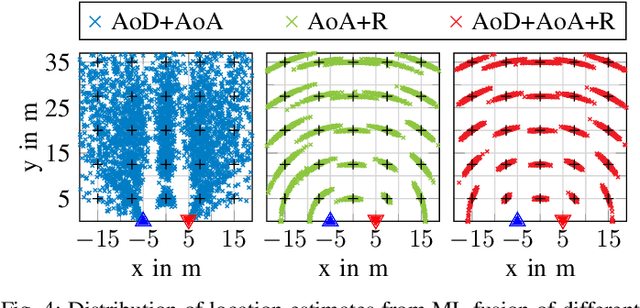
Abstract:The distributed nature of cellular networks is one of the main enablers for integrated sensing and communication (ISAC). For target positioning and tracking, making use of bistatic measurements is non-trivial due to their non-linear relationship with Cartesian coordinates. Most of the literature proposes geometric-based methods to determine the target's location by solving a well-defined set of equations stemming from the available measurements. The error covariance to be used for Bayesian tracking is then derived from local Taylor expansions. In our work we adaptively fuse any subset of bistatic measurements using a maximum likelihood (ML) framework, allowing to incorporate every possible combination of available measurements, i.e., transmitter angle, receiver angle and bistatic range. Moreover, our ML approach is intrinsically flexible, as it can be extended to fuse an arbitrary number of measurements by multistatic setups. Finally, we propose both a fixed and dynamic way to compute the covariance matrix for the position error to be fed to Bayesian tracking techniques, like a Kalman filter. Numerical evaluations with realistic cellular communications parameters at mmWave frequencies show that our proposal outperforms the considered baselines, achieving a location and velocity root mean square error of 0.25 m and 0.83 m/s, respectively.
Pilot-Based SFO Estimation for Bistatic Integrated Sensing and Communication
Jul 10, 2024Abstract:Enabling bistatic radar sensing within the context of integrated sensing and communication (ISAC) for future sixth generation mobile networks demands strict synchronization accuracy, which is particularly challenging to be achieved with over-the-air synchronization. Existing algorithms handle time and frequency offsets adequately, but provide insufficiently accurate sampling frequency offset (SFO) estimates that result in degradation of obtained radar images in the form of signal-to-noise ratio loss and migration of range and Doppler shift. This article introduces an SFO estimation algorithm named tilt inference of time offset (TITO) for orthogonal frequency-division multiplexing (OFDM)-based ISAC. Using available pilot subcarriers, TITO obtains channel impulse response estimates and extracts information on the SFO-induced delay migration to a dominant reference path with constant range, Doppler shift, and angle between transmit and receive ISAC nodes. TITO then adaptively selects the delay estimates that are only negligibly impaired by SFO-induced intersymbol interference, ultimately employing them to estimate the SFO. Assuming a scenario without a direct line-of-sight (LoS) between the aforementioned transmitting and receiving ISAC nodes, a system concept with a relay reflective intelligent surface (RIS) is used to create the aforementioned reference path is proposed. Besides a mathematical derivation of accuracy bounds, simulation and measurements at 26.2 GHz are presented to demonstrate TITO's superiority over existing methods in terms of SFO estimation accuracy and robustness.
Feasibility of Non-Line-of-Sight Integrated Sensing and Communication at mmWave
Jun 18, 2024Abstract:One rarely addressed direction in the context of Integrated Sensing and Communication (ISAC) is non-line-of-sight (NLOS) sensing, with the potential to enable use cases like intrusion detection and to increase the value that wireless networks can bring. However, ISAC networks impose challenges for sensing due to their communication-oriented design. For instance, time division duplex transmission creates spectral holes in time, resulting in spectral replicas in the radar image. To counteract this, we evaluate different channel state information processing strategies and discuss their tradeoffs. We further propose an ensemble of techniques to detect targets in NLOS conditions. Our approaches are validated with experiments using a millimeter wave ISAC proof of concept in a factory-like environment. The results show that target detection in NLOS is generally possible with ISAC.
Bistatic OFDM-based ISAC with Over-the-Air Synchronization: System Concept and Performance Analysis
May 08, 2024



Abstract:Integrated sensing and communication (ISAC) has been defined as one goal for 6G mobile communication systems. In this context, this article introduces a bistatic ISAC system based on orthogonal frequency-division multiplexing (OFDM). While the bistatic architecture brings advantages such as not demanding full duplex operation with respect to the monostatic one, the need for synchronizing transmitter and receiver is imposed. In this context, this article introuces a bistatic ISAC signal processing framework where an incoming OFDM-based ISAC signal undergoes over-the-air synchronization based on preamble symbols and pilots. Afterwards, bistatic radar processing is performed using either only pilot subcarriers or the full OFDM frame. The latter approach requires estimation of the originally transmitted frame based on communication processing and therefore error-free communication, which can be achieved via appropriate channel coding. The performance and limitations of the introduced system based on both aforementioned approaches are assessed via an analysis of the impact of residual synchronization mismatches and data decoding failures on both communication and radar performances. Finally, the performed analyses are validated by proof-of-concept measurement results.
EMF Exposure Mitigation via MAC Scheduling
Apr 19, 2024



Abstract:International standards bodies define Electromagnetic field (EMF) emission requirements that can be translated into control of the base station actual Effective Isotropic Radiated Power (EIRP), i.e., averaged over a sliding time window. In this work we show how to comply with such requirements by designing a water-filling power allocation method operating at the MAC scheduler level. Our method ensures throughput fairness across users while constraining the EIRP to a value that is produced by an outer-loop procedure which is not the focus of our paper. The low computational complexity of our technique is appealing given the tight computational requirements of the MAC scheduler. Our proposal is evaluated against the prior art approaches through massive-MIMO system level simulations that include realistic modeling of physical and MAC level cellular procedures. We conclude that our proposal effectively mitigates EMF exposure with considerably less impact on network performance, making it a standout candidate for 5G and future 6G MAC scheduler implementations.
 Add to Chrome
Add to Chrome Add to Firefox
Add to Firefox Add to Edge
Add to Edge